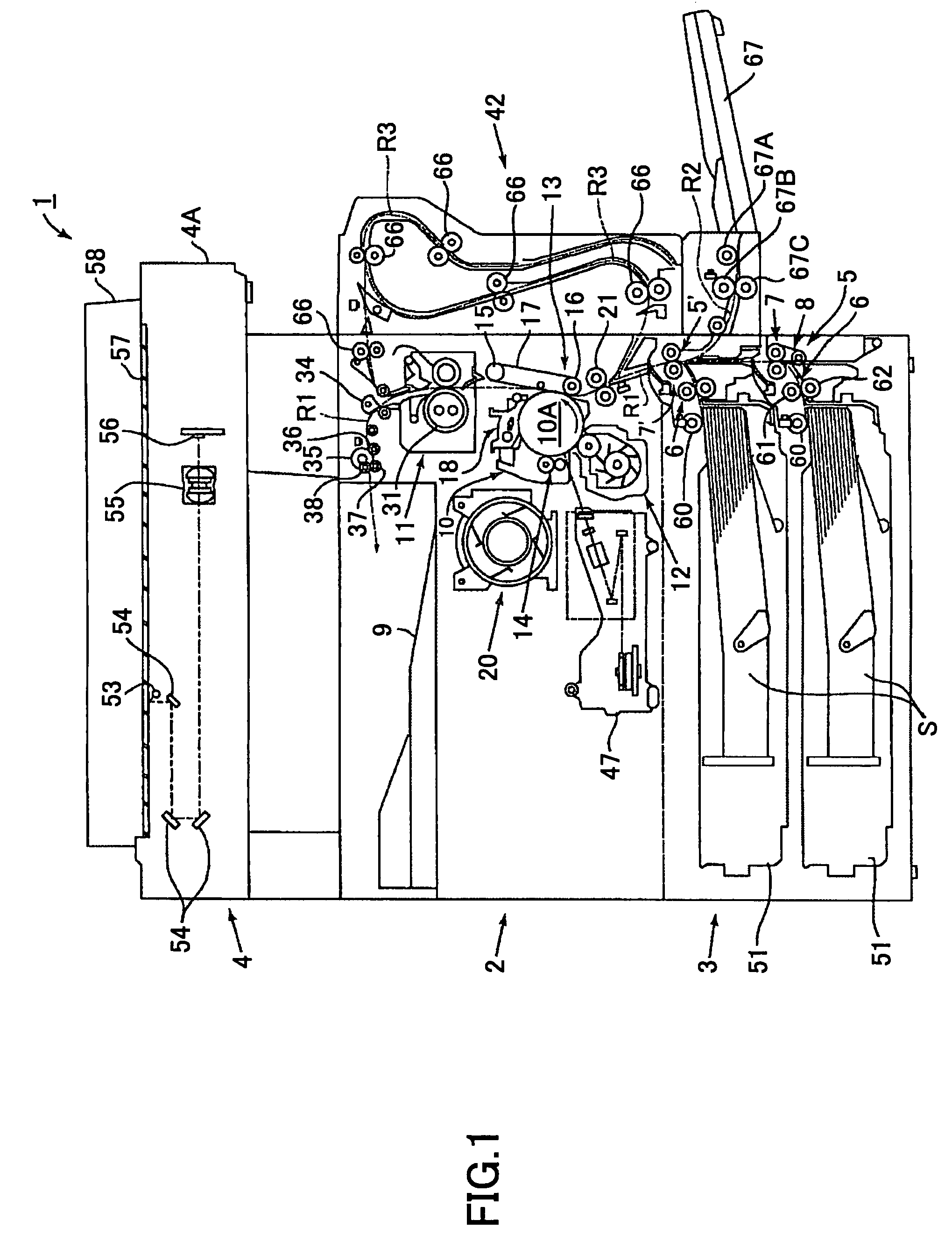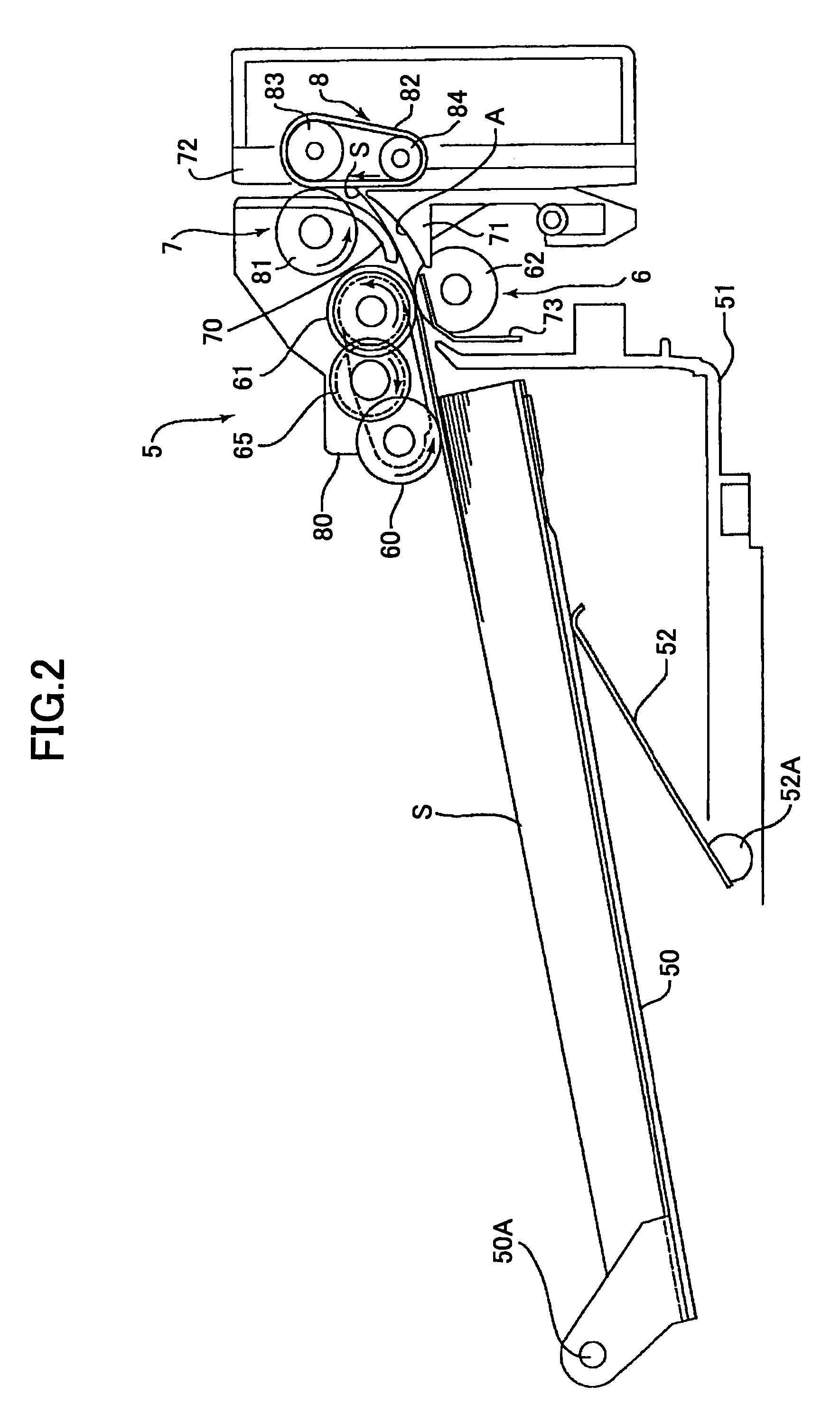Sheet conveying apparatus, image scanning apparatus, and image forming apparatus
a conveying apparatus and scanning technology, applied in the direction of instruments, electrographic processes, transportation and packaging, etc., can solve the problems of paper jam failure or a conveyance failure, the conveying force of the pair of rollers and the sheet feeding operation cannot be steadily performed. , to achieve the effect of simple and low-cost configuration
- Summary
- Abstract
- Description
- Claims
- Application Information
AI Technical Summary
Benefits of technology
Problems solved by technology
Method used
Image
Examples
first embodiment
[0077]FIGS. 1-3 illustrate a first embodiment of a sheet conveying apparatus to which the present invention is applied and an image forming apparatus including the same. FIG. 1 illustrates an overall configuration of a copier 1 as an example of an image forming apparatus according to an embodiment to which the present invention is applied.
[0078]The copier 1 is a monochrome copier that scans an image from a face of an original and forms a copied image onto various sheet-type recording media (hereinafter, “sheet”) such as recording paper, transfer paper, paper sheets, and OHP transparencies. The copier 1 includes an image forming apparatus main unit 2, a sheet feeding device 3 on which the image forming apparatus main unit 2 is mounted, and an original scanning device 4 attached on the image forming apparatus main unit 2. The image forming apparatus main unit 2 includes an image forming section for performing a predetermined image forming process based on a scanned original image. The...
first practical example
[0149]Next, a reference first practical example (hereinafter, “first practical example”) of the first embodiment to which the present invention is applied is described. A comparative test was conducted to compare the sheet conveying (sheet passing) properties of a copier according to the first embodiment to which the present invention is applied (indicated as “belt method” in Table 1) and a copier according to a conventional method (indicated as “conventional method” in Table 1). Among the components of “imagio Neo 453” manufactured by RICOH, only the sheet feeding device was modified to be used for the “belt method” of this test. The modified sheet feeding device used for the “belt method” basically has the same configurations and specifications as that of the sheet feeding device 3 of the sheet conveying apparatus 5 shown in FIGS. 1-3. For the “conventional method”, “imagio Neo 453” manufactured by RICOH was used, in this case including a sheet feeding device with a conventional s...
modification examples of first embodiment
[0173]FIGS. 6A-6C illustrate modification examples of the first embodiment to which the present invention is applied.
[0174]As shown in FIG. 6A, one member of the pair of rollers facing / contacting each other in the first conveying unit 6 can be the belt conveying unit 8. Furthermore, as shown in FIG. 6B, one member of the pair of rollers facing / contacting each other in the in the first conveying unit 6 and one member of the pair of rollers facing / contacting each other in the second conveying unit 7 can be the belt conveying unit 8 and a belt conveying unit 8′, respectively. Furthermore, as shown in FIG. 6C, a separate, independent belt conveying unit 8 can be provided as a moving / guiding unit alternative to one member of the pair of rollers in the first conveying unit 6 arranged on the upstream side or one member of the pair of rollers in the second conveying unit 7 arranged on the downstream side, and arranged between the first conveying unit 6 and the second conveying unit 7.
[0175]...
PUM
 Login to View More
Login to View More Abstract
Description
Claims
Application Information
 Login to View More
Login to View More - R&D
- Intellectual Property
- Life Sciences
- Materials
- Tech Scout
- Unparalleled Data Quality
- Higher Quality Content
- 60% Fewer Hallucinations
Browse by: Latest US Patents, China's latest patents, Technical Efficacy Thesaurus, Application Domain, Technology Topic, Popular Technical Reports.
© 2025 PatSnap. All rights reserved.Legal|Privacy policy|Modern Slavery Act Transparency Statement|Sitemap|About US| Contact US: help@patsnap.com



